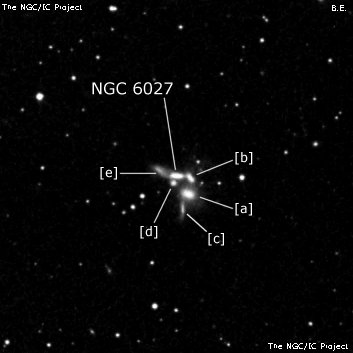
Édouard Stephan discovered NGC 6027 = St XII-78 on 20 Mar 1882 and measured an accurate position. Although Stephan recorded this ultra-compact group as only a single entry, his description "eF, vF* inv, 2 vF st nr" implies he probably resolved two or three members. Barnard ran across NGC 6027 while sweeping on 29 Jan 1889 with the 12-inch refractor at Lick Observatory.
Carl Seyfert's name was attached after his 1951 paper "A Dense Group of Galaxies in Serpens" (PASP...63...72S). Different lettering of the components were introduced by VV, RNGC and Hickson, so there is often confusion on the designations. There are likely only 4 galaxies in the group as NGC 6027D has a discordant redshift over four times the other members and NGC 6027E is considered either a tidal tail of HCG 79b or a partially dissolved remnant. Seyfert's Sextet is probably the densest (most compact) galaxy aggregate in the local Universe with all 4 members fitting within the confines of the Milky Way.
300/350mm - 13" (6/18/85): slightly elongated E-W.
13" (5/26/84): faint, very small, irregularly round, weak concentration.
400/500mm - 17.5" (5/14/88): faint, small, elongated ~E-W.
17.5" (6/6/86): this is Seyfert's Sextet = HCG 79, an extremely compact group! On close inspection, the confused "clump" resolves into three components with the brightest component (HCG 79b) appearing fairly faint, small. Extremely close are HCG 79a = NGC 6027A just 36" SSW and HCG 79c = NGC 6027B 22" W of center. A mag 14.5 star is 1.1' ESE and other faint stars are near. These three galaxies are just resolved at 220x.
900/1200mm - 48" (5/15/12): the brightest components of Seyfert's Sextet were NGC 6027 = HCG 79b and NGC 6027A = HCG 79a. Both were moderately bright at 610x, though NGC 6027 was more elongated at 2:1 E-W, ~20"x10". NGC 6027E, a diffuse plume, was easily visible extending 30" NE and narrowing near the end where it brightens slightly. NGC 6027D = HCG 79e is situated barely off the south side and appeared faint, extremely small, round, 6" diameter. NGC 6027B = HCG 79c (third brightest member) is just 24" W and appeared fairly faint, small, oval 3:2 SW-NE, 18"x12". Finally NGC 6027C = HCG 79d is furthest south (fifth brightest) and appeared faint, fairly small, very elongated 4:1 N-S, ~25"x7", with a low, nearly even surface brightness.
Notes by Steve Gottlieb